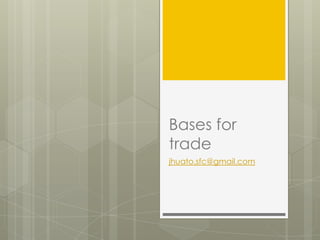
Int econ bases_trade
- 2. Goals Examine fundamental bases (or reasons) why economies trade Define the concepts of commercial advantage (absolute and comparative or relative) Understand the model of trade based on increasing MRT and differences in preferences (demand patterns)
- 3. Bases for trade Fundamental reasons for trade between countries arise from: 1. Differences in the preferences for the goods (with same cost structure, but increasing costs) 2. Differences in the cost structure of the goods (with same preferences) The analytical apparatus we studied help us highlight these bases for trade. Case (1), we‟ll study it next. Case (2), we‟ll study with the help of the Ricardian, Hecksher-Ohlin, and “modern” models of trade.
- 4. Trade theories („models‟): Same cost structure (with increasing costs) and different preferences (demand patterns) Different cost structures: Ricardian model (technology) Hecksher-Ohlin model (resource endowment) Modern theories (scale, increasing returns, monopolistic competition)
- 5. Commercial advantage Absolute advantage (AA): H is said to enjoy an absolute advantage over F if it can produce more than F of at least one good. Relative or comparative advantage (CA): H is said to enjoy a relative advantage in the production of good 1 over F if the MRTH12 < MRTF12. Corollary: If H has a comparative advantage in good 1 over F, then F has a comparative advantage in good 2 over H, i.e. MRTH21 > MRTF21.
- 6. Trade patterns If a country has a CA in a certain good (and therefore a comparative disadvantage in the other good), then that economy will have gain from trade if it specializes in the production of such good and exports it to the other economy. Thus, determining the CA of an economy allows us to predict its trade patterns: which good it exports and which one it imports.
- 7. Differences in preferences: no trade
- 8. Differences in preferences: with trade
- 9. Key points Note that H has a CA in the production of good 1 (and F in good 2), not because of differences in production possibilities (which are the same for both countries), but because – as a result of the different preferences – at the output and consumption bundle chosen in autarky, MRT12 < MRT*12, i.e. H can produce good 1 more cheaply than F at their respective chosen bundles, and so it makes sense for them to produce more of the good they have a CA in, and then trade it for the other good. This is the only case that we‟ll consider in which CA results not from the production possibilities, but from the different type of preferences between the two countries.
